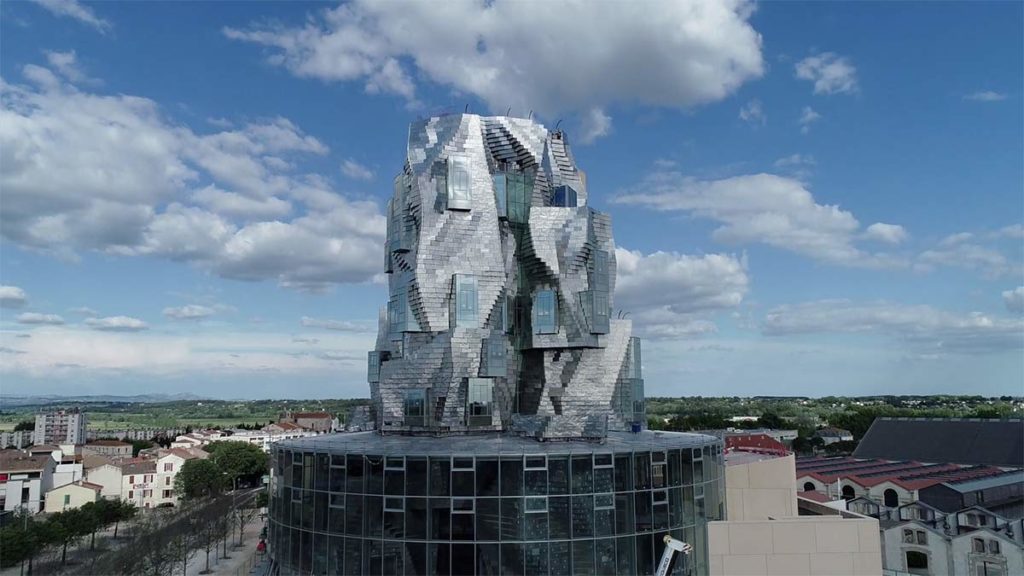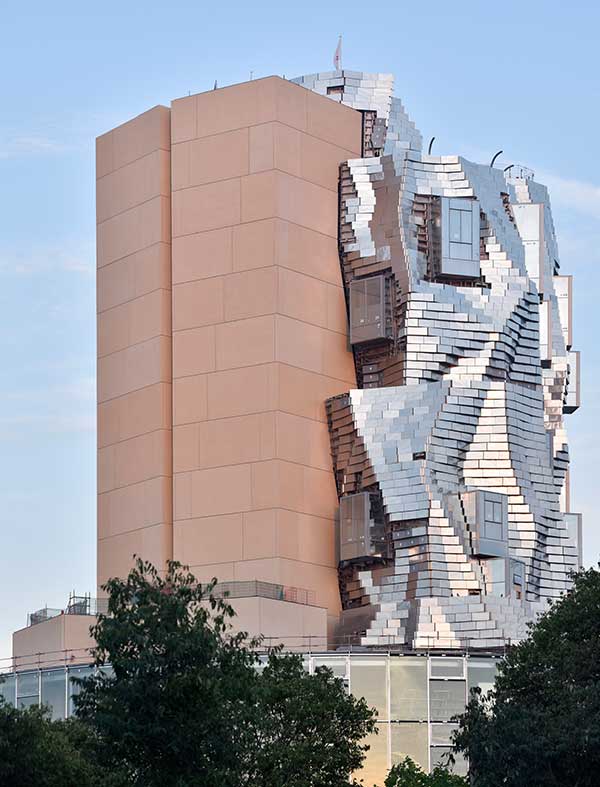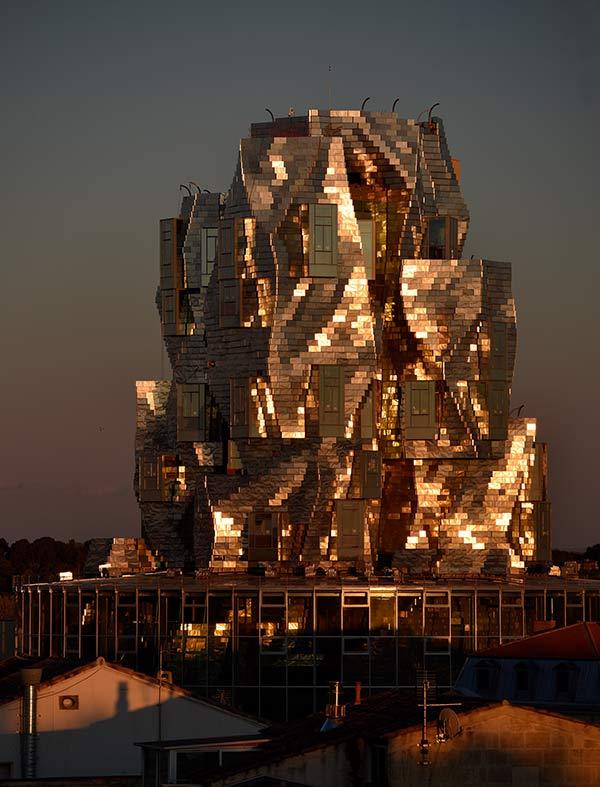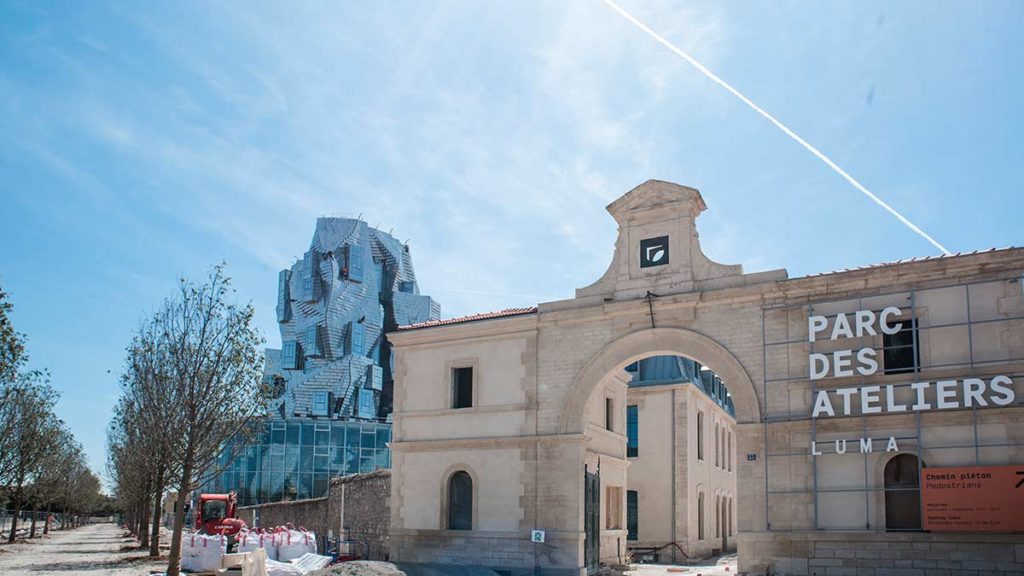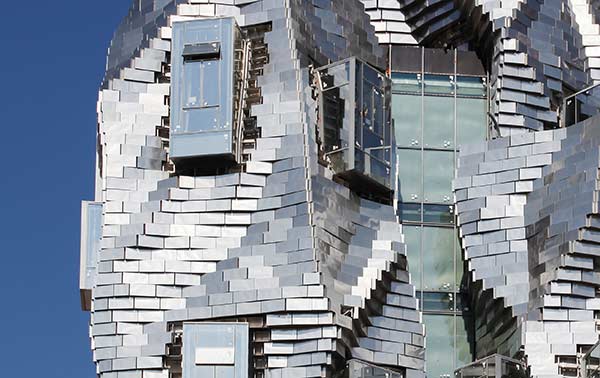The Tower of Arles
The mirrored tower designed by star architect Frank Gehry is the latest attraction in the southern French city of Arles, where it is hoped that the Bilbao effect will strike again. The new art hotspot, Luma Arles, is being financed by Swiss millionaire Maja Hoffmann.
Silver by day and golden by night. At a height of 56 metres, the Luma Arles tower reflects the available light in alternating shades depending on the time of day and the angle at which its façade elements are reflecting. Star architect Frank Gehry used a total of 11,000 aluminium panels for the building shell. To the observer, these resemble digital pixels of a rock that has been zoomed in on from afar. This may well be a nod to this spectacular building’s intended function as a hotspot for new art forms.
Gehry’s Arts Resource Building, to give the tower its official name, has added a new chapter to the deconstructivist style of architecture. He is regarded as one of the most important protagonists of this style, leading him to be dubbed the “Picasso of architecture”. His house in Santa Monica has gone down in the annals of architectural history as the first ever deconstructionist building.
Architecture: an important economic driver
The spectacular style now also has a deliberate economic component factored in. Gehry’s design for the Guggenheim Museum in Bilbao resulted in an unforeseen boom for the Basque capital. And the southern French city of Arles is now pinning its hopes on the “Bilbao effect” occurring again there too.
High unemployment and gloomy economic prospects have led to a widespread feeling of hopelessness in the old Roman city. Like many other provincial towns and cities, Arles was hit hard by the decline of local industry. The machine shops of the French state railway, which once employed 1,200 people, were closed down back in 1984. It is these same grounds, the Parc des Ateliers, that are now to be the focal point of the economic turnaround.
Maja Hoffmann, joint heir to Swiss pharmaceuticals group Hoffmann-La-Roche, already acquired this large area – covering several hectares – ten years ago for some ten million euros. She also invested a further 150 million euros in expanding the new cultural centre, making it one of the largest private cultural projects in Europe.
Luma Arles, an interdisciplinary think tank
Luma Arles, the first phase of which was opened in 2018, operates as a kind of interdisciplinary think tank. The centre aims not only to celebrate contemporary art and new media, but also to offer an idea pool and a lively exchange on ecology, culture and human rights. The exhibition concept is also to be completely revisited. Artists, scientists, philosophers and researchers from a wide cross-section of fields are being brought together to work on joint projects here. This means that Luma has an important advantage over the new mega-museums in the world’s largest cities: while these remain largely rooted in conventional art categorisations and presentation forms, Arles is thinking well outside the box.
Criticism of Hoffmann’s influence
It is an ambitious project that would not be possible without Maja Hoffmann’s financial and ideological support. Through her involvement, the entrepreneur would like to show what an impact art and culture can have on a town or city. Hervé Schiavetti, the communist mayor of Arles, is wholly in support of the art-loving pharmaceuticals heir. He believes that her efforts will help to raise the profile of his city and spread its reputation to New York, London and Berlin. Luma Arles is also expected to attract between 300,000 and 500,000 visitors annually to the historic city in Provence. This will naturally be reflected in economic growth.
Nonetheless, just like the Tower of Babel, many people have yet to get the message. And some feel that the “Queen of Arles”, as she has been dubbed by the French media, has too great an influence. Hoffmann acts as a kind of regional incubator. As well as her involvement in Luma Arles, she is on the supervisory board of the Van Gogh Foundation. She is also the owner of organic Michelin-starred restaurant “La Chassagnette” and several upmarket hotels in the area. And she finances Rencontres d’Arles, one of the world’s most important photo festivals.
Even though Gehry’s tower will not be fully usable until 2021, the influence of the new art and cultural centre is already evident. South Korean artist Lee Ufan has just commissioned Japanese star architect Tadao Ando to convert an old townhouse into a mega-gallery. Further galleries, hip stores and pop-up bars are opening all over downtown Arles. And members of the Parisian jet set are already frequenting the formerly rundown La Roquette district.
Text: Gertraud Gerst
Translation: Rosemary Bridger-Lippe
Photo: Getty Images, Hervé Hote, Joana Luz, Arles Tourisme
